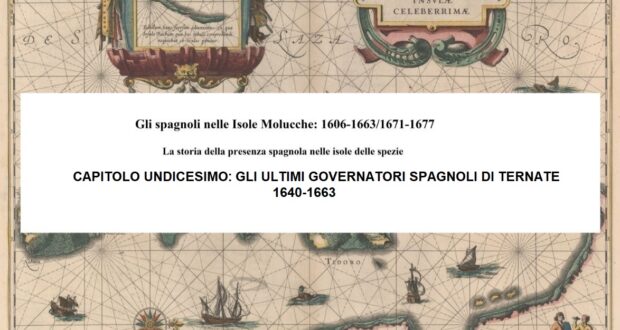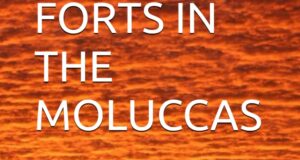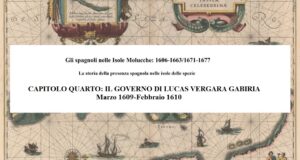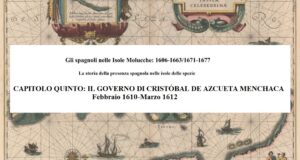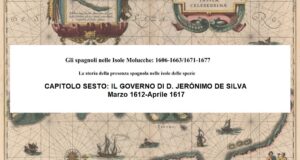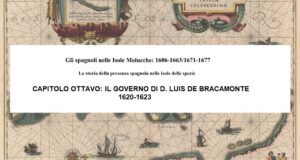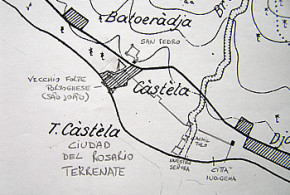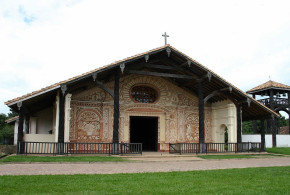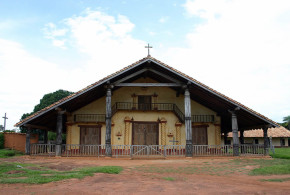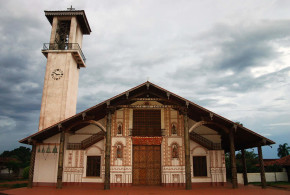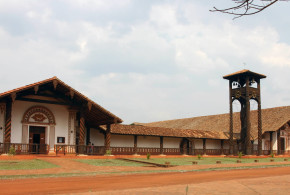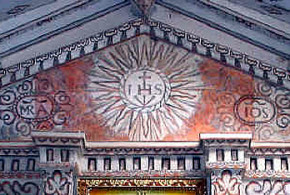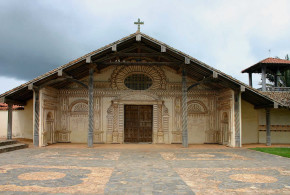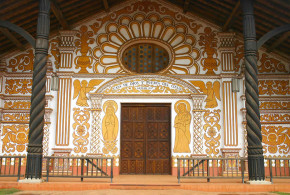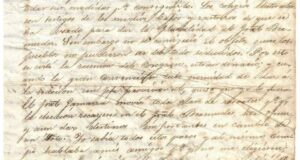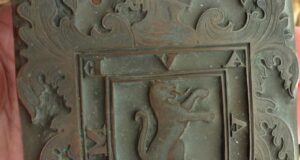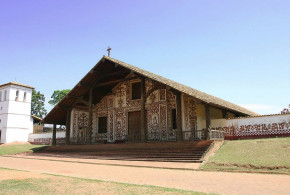This post is also available in:
![]() Italiano
Italiano
The Spaniards in the Moluccas: 1606-1663/1671-1677. The history of the Spanish presence in the spice islands
Written by Marco Ramerini. 2005-2020/23
CHAPTER ELEVEN: THE LAST SPANISH GOVERNORS OF TERNATE, 1640-1663
D. FRANCISCO SUÁREZ DE FIGUEROA Y ACEVEDO, January 1640-1642
The new governor D. Francisco Suarez de Figueroa had left Spain for the Philippines in 1608 together with D. Juan de Silva, with whom he had family ties and had served the king in Ternate during the rule of D. Gerónimo de Silva.1 He succeeded Pedro Muñoz de Carmona y Mendiola on January 23, 1640.2
In 1640 the cost that the crown of Spain bears for the maintenance of the Moluccas is more than 230,000 pesos a year, divided as follows: 97,128 pesos for wages, 30,000 pesos for supplies, 4,000 pesos for religious and real treasury administrators and finally 100,000 pesos for the fleet.3
During the government of D. Francisco Suárez de Figueroa requests for religious arrived from the island of Celebes, according to what the Franciscan friar Juan Iranzo4 (Iranço) writes from Manados, many inhabitants of the island (he gives the figure of 100,000 people) would like to become Christians. By friar Iranço, 13 or 14 chiefs of Manados had been sent to Ternate to educate them in the Catholic religion, they were baptized in the convent of San Antonio. The inhabitants of Manados are described as extremely industrious, of robust constitution and fair complexion, while the island is fertile and rice and other cereals grow there in abundance. Following this request, the governor of the Moluccas sent a champan with 12 Spaniards and a religious (friar Lorenzo Garraldo or Garalda5) to help friar Iranço, the leaders of Manados previously baptized in Ternate also embarked on this boat.6
The relief of 1640 had as captain general of the ships and the galley, the old governor, D. Pedro Muñoz de Carmona y Mendiola.7 With the same assistance also arrived Martín Sánchez de la Cuesta, the newly appointed adjutant of the sergeant major of Ternate.8
On January 1, 1641, the “socorro” fleet sent from Manila to Ternate stopped in the garrison of Zamboanga (island of Mindanao), it consisted of a galley, two “pataches” and eight “champanes”.9 Relief troops to the Moluccas are usually sent from Manila during November-December, as that is when the northerly winds blow. The reverse journey (Moluccas-Manila) is instead carried out starting from mid-May, when the winds blow from the south.10
In 1641, Martín Sánchez de la Cuesta, serving as adjutant to the sergeant major, having captured a Spanish “parao” between the fort of Sancta Lucia and the “Rrio Grande” by the Dutch and Ternatese, was sent, by order of Captain Don Francisco del Castello Caueza de Baca (who was superior head of the galleys), in pursuit of the enemies with 15 Spaniards and as many “merdicas”, an armed confrontation ensued where the Dutch were put to flight and were forced to retreat to their Malayo force.11
In 1642 some villages (called Meados) of the kingdom of Manados rose up against the Spanish, apparently due to the behavior of some Spanish traders who were there to buy supplies. The Franciscans who had a mission there also paid the price for this upheaval. Friar Lorenzo Garraldo (Garalda) was killed after 7 days of punishment, on February 13, 1642, together with some of the Spanish traders, by the islanders at the instigation of the village sorcerers, while the other Spaniards together with friar Juan Yranzo managed to escape.12
D. PEDRO FERNÁDEZ DEL RIO (which does the functions), 1642-1643
During 1642 the usual relief fleet was sent from the Philippines to Ternate, it consisted of a galleon (San Juan Bautista) and a patacco, in command of the expedition was Pedro Fernández del Rio, general of the “socorro”. The Dutch who were waiting for Spanish help to attack them were repulsed, thanks to the excellent conduct of the commander of the Spanish ships, Fernández del Rio, and were forced to retreat to their fortress of Malayo. The two Spanish boats with their cargo arrived safely in the port of Ternate. The commander of the expedition, Pedro Fernández del Rio, was shortly after appointed by the governor of the Philippines governor of the Moluccas, the old governor, D. Francisco Suárez de Figueroa, was placed under arrest.
Governor Pedro Fernandez del Rio gave Martín Sánchez de la Cuesta the task of defending the fortifications of Ternate. During a Dutch attack on two “caracoas” of the king of Tidore who were loading goods, Martín Sánchez repulsed the enemies with great promptness and speed, saving the two Tidorese boats.13
The brief period of government of del Rio, was punctuated by clashes with the Dutch and was a period of fervent renewal of the Spanish fortifications on the island of Ternate, in fact, under his government the fort of San Pedro was renovated, “retirada dela ciudad del Rossario de Therrenate puesto principal para su defensa”, the fort in question was the one designed at the time of Juan de Esquivel and located on a hill behind the city of Ternate. The “cavallero” of San Juan was finished with his “reuellin”, the powder magazine and the platform, this bulwark was the one that controlled the side of the walls towards the countryside (“que barre todo el lienzo que mira a la campania”). In addition, the wall on the eastern side was reinforced “que mira ala parte del enemigo” whose thickness was increased to 4 feet, on the same side the “cavallero” of Cachil Tule was also reinforced who controlled all this part of the wall and was also in defense of the indigenous settlement which was located outside the walls.
A galley was then built, the present one being old and dilapidated, it was the first built by the Spaniards in the Moluccas and was equipped with 14 “bancos”. Thanks to the presence of this new boat, the Spaniards were able to effectively face the Dutch, who up to that moment had carried out, with their light boat, several raids against the island of Tidore and also kept Ternate at gunpoint. With the new galley instead the Spaniards counterattacked managing to inflict some hard defeats on the Dutch: in a naval battle the Dutch light boat was captured which had previously done so much damage to the Spaniards, this clash took place near the Dutch fortress “a tiro de pieça de las fuerças del olandes” and 6 Dutch and 60 natives were killed or captured as well as all the artillery of the boat. Other boats were captured in other engagements where the Spanish captured 167 men. Following agreements with the Dutch, 57 Christians were released from Dutch prisons, including 18 Spaniards.
In that year, 14 Dutch ships and an important number of soldiers were in Ternate. The Dutch with about 800 soldiers attempted an attack against the Spanish, but thanks to the courage of the governor and some captains, the Spanish troops managed to face the superior Dutch troops forcing them to retreat to their fort. During his two years of government, del Rio maintained cordial relations with the King of Tidore and with his subjects, moreover he administered justice righteously maintaining peace and friendship between Spaniards and allies. After the arrival of his successor, Lorenzo de Olaso, Don Pedro Fernández del Rio remained in Ternate in command of a company of Spanish infantry.14
D. LORENZO DE OLASO ACHOTEGUI, 1643-1649 (?)
With the “soccorro” of 1643 with which the new “mestre de campo” Lorenzo de Olaso arrived in Ternate, many infantry soldiers also arrived to reinforce the defenses of the Spanish garrisons, constantly threatened by the Dutch. This became even more necessary after the news of the fall of Malacca to Dutch hands. A galleon, two galleys and a patacco were part of the “soccorro” of 1643. One of the galleys was en route to make an embassy to the king of Macazar (perhaps Manados) requesting iron, gunpowder and other war materials, but this vessel was shipwrecked and the occupants, who were all saved, embarked on the others ships. The expedition reached Ternate without problems, despite the presence of 4 Dutch ships, which, however, avoided attacking the Spanish convoy. After arriving in Ternate, the other galley was sent to Macazar (Manados) where the king promised to send the requested goods to Ternate soon. During this year the Dutch received no help from Holland, only two small boats came to the rescue of the Dutch in Ternate.15
Probably with this “soccorro” the Spanish Jesuit Fernando de Estrada also arrived in Ternate, he had left Manila in January 1643, his sending was the first attempt by the Spaniards to pass the jurisdiction of the Moluccas to the Jesuit province of the Philippines and take it away from that, Portuguese, from Malabar. The reasons are mainly to be found in Portugal’s rebellion against the Spanish crown. The Jesuit remained in Ternate for almost 2 years, he was then recalled in 1644 to Manila by the governor Diego Fajardo who re-established the Portuguese Jesuits in their place.16
In the same period, the Spaniards replaced the Portuguese vicar, Tomé Alvares, with Don Fabian de Santillana y Gabilanes on the orders of Corcuera, governor of the Philippines. Corcuera informs us that in those years six companies of Spanish soldiers, two companies of pampangos and one company of mardicas were present in the garrisons of the Moluccas.17
In 1643, Lope de Colindres, being a soldier in the company of the “mestre de campo” Don Lorenço de Olasso, embarked with him for Ternate, where he was in charge of the fort of San Lucas del Rumen. He returned to Manila with the fleet under sergeant major Palomino.18
In 1644 the composition of the Spanish troops stationed in the presidios of the Moluccas was as follows: one sergeant major, two adjutants, six companies of Spanish infantry with 44 officers and 560 soldiers; an artillery captain with 26 gunners; three “pampaga” infantry companies with 18 officers and 180 soldiers and 20 “mardicas”. While a Spanish infantry company made up of 7 officers, 100 soldiers and 8 artillerymen was embarked that year for Macasar (Manados ?).19 At the end of October 1644, reinforcements for Ternate were sent from Manila.20
Ternate is also used as a place to exile unwanted people to the Philippines. Captain D. Diego de Inojosa Villavicencio, was exiled to Ternate by the chancellor of Governor Fajardo, D. Manuel Estacio Venegas, he managed to escape from the island in October 1647 by embarking on a Danish ship which was anchored in the Dutch port of Malayo, with this boat he reached Batavia, here on board a Dutch ship he reached Holland and then finally Madrid.21
D. PEDRO FERNÁDEZ DEL RIO (second term), 1649 (?)
In 1648, the King issued a “Real Provisión” granting the captain and sergeant major Pedro Fernández del Rio the title of “alcaide de la fortaleza de Terrenate y gobernador de la gente de Guerra de aquel presidio”, a title which had remained vacant due to of the death of the captain, Francisco Suárez de Figueroa y Acevedo.22
This second government mandate which was entrusted to Pedro Fernández del Rio had a very short duration, according to Colin-Pastells he died twenty days after his arrival in Ternate.23 However, other documents seem to indicate different things: D. Pedro Fernández del Rio was certainly in Ternate on 1 April 1649 and signed himself as governor.24 On August 3, 1649 Pedro Fernandez del Rio was still governor of Ternate because he appointed Miguel de Guinea as captain of the ‘patron’ galley. He was no longer governor on April 14, 1650.25
Some information on this short period of government is provided in the report on the merits of Captain Martín Sánchez de la Cuesta: Starting from 1649, Martín Sánchez de la Cuesta served in Ternate with his company, later he was given the position of sergeant major. He was then sent by order of Governor Pedro Fernandez del Rio to the forts of San Lucas del Rumen and Chobo. Having received a request for help from the king of Tidore, Cachil Sayde, who had a village under Dutch and Ternatese attack, rescued him with Spanish troops, routing the enemies. Having then received news of new Dutch preparations for a more massive attack on Tidore, the governor Pedro Fernandez del Rio, unable (he was engaged in the fortification of Ternate) to intervene directly in aid of the king of Tidore, sent Martin Sanchez de la Cuesta to Tidore as head of the island and in charge of the main fortress of Tidore called Sanctiago de los Caualleros, of the “fuerte Principal” (of the Prince (?)) and that of Puli Cauallo.
In agreement with the king of Tidore it was decided to attack the Dutch in Malayo. The attack took place, with 60 Spanish soldiers, some “pampangos merdicas and siaos” and the king of Tidore with 100 Tidorese, and was directed towards the bastion of the fort of Malayo which the Dutch call “Punta Real” (the bastion on the southwest side of the fort). The Spanish had a small clash here with the defenders of the bastion who were forced to take refuge inside their fort. Then Captain Juan Ruston (?) came out of the fortress of Malayo with 124 Dutch musketeers, the king of Jilolo with 500 Ternatese, the ambassador of the king of Mindanao with 200 “moros” and the “sangaxe”, don Juan, governor of the ” pueblo de los merdicas” with 200 men. The ensuing battle was a great victory for the Spanish, who captured 94 Dutch including the Dutch captain, only 11 of the Dutch soldiers managed to escape (19 evidently died). Given the defeat, the Dutch governor sent other troops under the command of Captain Pablo Andrea, who however did not dare to attack the Spanish troops and remained under the protection of the walls of the fort of Malayo (probably this episode took place in 1650). The Spanish victory and the capture of such a large number of Dutch allowed the exchange of prisoners, both soldiers and sailors were ransomed and also two priests.26
D. FRANCISCO DE ESTEYBAR (doing the functions), 1650 or 1652-1656
D. Francisco de Esteybar appears to have ruled Ternate between March 1650 and May 1656.27 After the death of Fernández del Rio, the governor of the Philippines entrusted the interim government of Ternate to General Francisco de Esteybar.28 Francisco de Esteybar appears to have taken office as governor of Ternate on March 10, 1650.29 On June 4, 1650 Francisco de Esteybar is governor of Ternate.30 Confirming that he governed Ternate in 1650 is also his declaration: ‘el año de seis y cinquenta que tomé posesion de este govierno’31
In 1651, having received (through the Dutch fleet arriving from Europe) the news of the peace between Spain and Holland, Martin Sanchez de la Cuesta was sent, by order of the governor of Ternate, to negotiate with the Dutch governor Gaspar Bandes Bogardes (Gaspar van den Bogaerde).
The Jesuit missions of the Moluccas and the college on the island of Ternate finally passed definitively under the jurisdiction of the province of the Philippines (Manila) in 1654, until then the missions had been subject to the Jesuit province of Malabar (Cochin). This step occurred during the government of Manrique de Lara. The cause that led to this decision was mainly the Portuguese rebellion which definitively detached Portugal from the Spanish dominions.32 In 1651 on the island of Sanguil (or Calonga), where the king, Don Juan Buntuan, was a Christian, the Franciscan friar Joseph de Truxillo was sent, here he with the help of another Franciscan Mateo Rodriguez built a church and converted many people.33
From 1653 to May 1656, Jacob Hustaert was the Dutch governor of the Moluccas.34 In 1654, in Cavite, the works for the construction of a galley were completed, its construction having been begun under the government of Governor Fajardo. This galley was sent to Ternate with the “socorro” of that year and remained there in defense of the garrison.35
The “socorro” of 1654 was abundant, eight “champanes” were sent loaded with soldiers, ammunition, food and money. Six companies of Spanish infantry and three companies of “pampanga” infantry were present in the “presidios” of the Moluccas. The relief came at a crucial moment, in fact hostility had broken out between the Ternatese and the Tidorese, due to the help given by the king of Tidore, Cachil Sayde, to the rebels who had risen against the sultan of Ternate.
The Dutch, always allies of the sultan of Ternate, declared war on the king of Tidore. The Spanish governor Esteybar, on the other hand sided with the king of Tidore, there was a risk of war between the two parties despite the peace treaty of Westphalia. However, orders came from Manila from Governor Manrique de Lara to avoid a direct confrontation with the Dutch. According to orders, the king of Tidore was to immediately cease hostilities against the Ternatese and Dutch and stop helping the rebels. If the king did not comply with the orders, authorization was given to Esteybar to capture Cachil Sayde and detain him until he complied with the orders. The king was captured by the Spanish and agreed to suspend the war. However, the Dutch were not satisfied with the outcome and claimed the head of Cachil Sayde, but Esteybar refused to hand him over, leaving him free to govern Tidore.36 Probably the rebellion of some of Ternatese was due to the succession struggles for the role of sultan of Ternate. The succession then took place with the help of the Dutch in 1655.37
On December 7, 1654, Hernando López del Clavo was appointed captain of one of the two companies of the ‘socorro’ army for Ternate, an army which was led by Captain Hernando Ponze de Viruez (‘regidor’ of the city of Manila). With this assignment he went to Ternate, then on the return journey to Manila, on the order of the governor of Ternate, Francisco de Esteybar, he also stopped in the kingdom of Siao, where he brought two religious. On the next journey to the Philippines, on the shallow waters of an island (Cagayanes Island), he wrecked the ‘captain’ ship. But thanks to the prompt intervention of Hernando López del Clauo, most of the men and material embarked on the ‘captain’ ship were saved and loaded onto his boat.38
In 1654, Manrique de Lara informs us that the Spanish had peace treaties with the kings of Macasar, Camboya, Tidore, Calonga, Manados, Mindanao, Jolo. According to Lara, the king of Macassar was the one who showed himself to be the friendliest to the Spaniards.39
Also in this period the island of Ternate was often used as a place of confinement, for example the captain Onofrio Lombardo was sentenced in 1656 to 10 years of service as a soldier in Ternate.40
THE JESUIT MISSIONS
In 1655 there are three Jesuits present in this mission, one is the rector of the mission who lives in the college of Ternate from where he deals with the spiritual care of the Spanish garrisons and the natives of the islands of Ternate and Tidore and the village of Mardicas. The other two missionaries take care of the many stations on the other islands. The main and also the oldest of all these missions is the one in the kingdom of Siao where there are currently about 4,000 Christians. From this mission Christianity spread to several other nearby islands, there are Christian villages on the island of Sanguil Baçar (also called Tabuco)41, in the islands of Talaos42 and in the island of Matheo (Manados or Macasar). In Calonga (or in the nearby village of Taruna), the capital of the island of Sanguil Baçar, a Franciscan friar lived and there was a garrison of Spaniards. In Manados, in the past there were about 4,000 Christians, but now due to the continuous attacks by the Dutch and Ternatese, the Christian religion has almost completely disappeared. All the old missions in the islands of Gilolo and Morotai have long since been abandoned, again due to the wars with the Dutch.43
In a document signed by the Attorney General of the Philippines, Francisco Vello, it is stated that the King of Tidore is a Christian, but this is not true.44 In 1655 the Jesuits have three priests in the missions of the Moluccas, they were Father Vicente Choua, Father Francisco Miedes and Father Diego de Esquivel.45
DIEGO SARRIA LASCANO, 1656-1658
In the Seville archive there is a report of the merits of this governor, but it refers to the years preceding his government in Ternate. This report informs us that Sarria Lascano, after having served in the armies of Don Fradrique de Toledo and in the galleons of the “plata” was licensed to move to the Philippines and Ternate, where he served for nine years as a soldier, ensign, captain and admiral. He particularly distinguished himself in Mindanao and Jolo. In 1642, he was appointed admiral of the “socorro” who was to be sent to Ternate. Later he was appointed “alcaide y castellano” of Ylo Ylo, governor of Oton and “probeedor general” of the Ternate forces, with this position he rescued the garrisons of the Moluccas twice in two years.46 The relief of 1656 was regularly sent, the same had happened in the previous two years.47
D. FRANCISCO DE ESTEYBAR (second term), 1658-1659
In the report on merits, a small mention is also made of his second government in Ternate, in which it is noted that thanks to his experience and authority, he is quelling and settling the unrest and doubts that the Ternatese (“los moros de aquella tierra ”), allies of the Dutch, have introduced into the “Moors”, the Tidorese, allies of the King of Spain.48
THE LAST SPANISH GOVERNORS
In the last years of the Spanish presence in the Moluccas there were several governors of which there is not much information. The first is D. Francisco de Atienza Ibáñez who will govern for an initial period between 1659 and 1660 (?) and then will also be the last Spanish governor of Ternate.
The others are Francisco Prado de Quiros who governed Ternate between 2 May 1660 and 15 December 1660.49 Juan de Chaves, who will rule for a short time between 1660 and 1661, and finally D. Agustín de Cepeda Carnacedo, who will be governor of Ternate between 1661 and 1663.
In 1662, the dismantling of the garrisons of Zamboanga, Ternate, Calamianes and Iligan was decided. The aim was to concentrate the few troops available on the defense of Manila, which was feared to be attacked in a few months by a huge Chinese fleet.50
THE ABANDONMENT OF THE MOLUCCAS
In December 1662, Governor of the Philippines Manrique de Lara wrote to General Francisco de Atienza Ibáñez, charged to be the last governor of Ternate, instructions for the dismantling of the Maluku garrisons. This decision was made out of fear of an attack on the Philippines from the island of Formosa by Koxinga’s troops. The feared attack never materialized.
However, the Spanish took care to make the Dutch and their allies understand and accept that the abandonment of the garrisons did not mean the abandonment of the possession rights that the Spanish had over the Moluccas, on the contrary the Spanish practically asked that the Dutch not only not occupy abandoned Spanish forts, but also prevent anyone else from doing so.51
On 25 March 1663 the new and last Spanish governor arrived in Ternate; he had the task of making the Spanish garrisons withdraw from the islands, dismantling the forts and negotiating with the Dutch the rights which, despite the abandonment and dismantling of the Ternate and Tidore, the Spaniards reserved to keep on the Moluccas islands. The Spanish fleet, this time, consisted of 14 empty junks.52
In accordance with the orders of Manrique de Lara, the dismantling of the Spanish forts had to follow a precise criterion which was to transport all the material (ammunition, artillery, etc.) removed from the dismantled forts “alas fuerzas del Rumen”53 on the island of Tidore, which was to remain the last place to be demolished, because it was here that was the most important and safest port in the hands of the Spaniards. All the Spanish fortifications of Ternate and Tidore were to be, according to Manrique de Lara’s intentions, completely demolished and then set on fire. All the work had to be completed within the monsoon period “que no se pase la monson de la buelta”.54
In the “certificación” written by the governor Francisco de Atienza Ibáñez in Manila and dated 10 December 1666, the dismantling works of the Spanish fortifications and the destruction of the buildings in the city of Ternate are described. Were demolished, the bastions San Felipe, San Xpoual (= San Cristoval), Santiago, San Agustin (most likely it is the name of the old bastion of Cachil Tulo), San Juan, San Lorenzo, Sant Pedro “retirada della” (i.e. the fort built on a hill overlooking the city) and the “cube” of Nuestra Señora. Baluarte Don Xil (Gil) and Fort San Francisco Calomata were also demolished. While the houses, churches and convents of the city of Ternate were set on fire.55
On May 29, 1663, a last Spanish delegation was sent to the Dutch governor Van Voort. The mission was headed by the Jesuit Diego de Esquivel, with him were the insign Juan Garcia, the captains Francisco Sanchez and Nicolas Rodriguez and the adjutant Francisco de Gayeta. They were received on the Dutch side by the major factor and commissioner Nicolant, the fiscal Croon, the factor Jacobus, the secretary of justice and the preacher Jon Sabellius. The negotiations were conducted in the Latin language.
The Spaniards reaffirmed their rights on the dismantled garrisons, affirmed that the rights of the King of Spain remained unchanged even if he did not garrison his forts with troops, furthermore they affirmed that the Ternatese could not claim rights on the Spanish garrisons because they had been conquered during the war and they were confirmed at the making of the peace by the treaty of Munster. Furthermore, the rights of “dominion” allowed him to do what the King wanted with his own possessions, even destroying them, without however losing the right of ownership.
The Dutch replied asking if in case of occupation by the sultan of Ternate they had to defend the possessions of the King of Spain with their own weapons, the Spaniards said that the King of Spain had his own army and with this he would have asserted his rights on anyone who trampled on them, without thereby being accused of breaking the peace. The Dutch then objected that destroying and completely demolishing their palaces and forts connoted the intention of the Spanish never to return to occupy these places, but the Spanish replied that instead this was the “mayor accion de dominio que podia hacer el Rey nuestro señor”. At the end of the talks, the Dutch decided to defer to the decisions of Batavia, so they did not endorse the Spanish requests.56
From the correspondence between Atienza and the Dutch governor of Ternate, Antonio Van Voort, it is clear that the Spaniards abandoned the city of Ternate on May 29, 1663, moving to Rume from where they wrote several letters dated May 30, 1663. Therefore it seems plausible that among the last day of May and the first days of June 1663, the last Spanish troops left the island of Tidore. It was the last episode of a relationship that began 142 years earlier with the arrival in Tidore of Magellan’s expedition on November 8, 1521.57
A few days after the Spanish had left Ternate, on June 11, 1663, the Dutch commander of Fort Malayo and the Ternate sultan Mandarsaha (Manlarsaha, Mandar Shah), visited the remains of the Spanish city, they found a ghost town, where the walls had been demolished, houses and monasteries both in the castle and in the Mardijkers quarter had been set on fire. Fort San Pedro had also been partially destroyed although in the opinion of the Dutch it could be repaired.58
Soon after the Spanish departure, the king of Tidore occupied the forts on his own island which the Spanish had abandoned and attempted to destroy. A contingent of 40-50 of the king’s soldiers occupied the fort of Rum (Romi) at a time when the Spanish were leaving. The king of Tidore, not content with having occupied the Spanish forts of his island, also had designs on the castle of Gammelamme, by virtue of the fact that his ancestors had collaborated, in 1606, together with the Spanish in the conquest of the fort and for this reason he felt right to occupy the fort.59 On 18 June at the invitation of the king of Tidore, the Dutch commander visited the Spanish fort of Rum (Romy) together with the king, finding it in excellent condition, only the staircase and the balconies of the upper fort had been destroyed, some buildings had been filled with wood by the Spaniards with the clear intention of burning everything before leaving, but something or someone (the Tidorese) had prevented them from completing their plans. According to the Dutch report the fort of Rum (Romy) was formed by a fortification at beach level called “the platform” which continued upwards in a triangular shape, completing this structure were three small redoubts. Even the upper fort was in good condition and kept its walls intact, on the side facing the sea there was also an iron cannon.60
The fort of Tahoela, was donated by the Dutch, after the Spanish had abandoned it, to the Sultan of Tidore, here he established his residence, in the fort the Dutch maintained a guardhouse of 8-10 soldiers.61 According to Pastells, Tahula (“la fuerza grande de esta isla”) was occupied by Golofino to whom the Dutch gave 16 soldiers as a guardhouse. The other garrisons were further destroyed by the Dutch who used much of the stone to improve the fortifications of Malayo.62
According to a Dutch report from 1707, after the departure of the Spanish the King of Tidore accepted the Dutch request and the promise of 300 Rs.s to demolish the forts of Tahoele, Romij and Tiobbe. But the forts were not completely dismantled, upon the request of the king, which was approved by the company on January 19, 1666, the Tahoele fort was kept as a royal residence. Furthermore it was ordered by the company not to proceed with the destruction of the forts of Romij and Tjobbe but to leave their walls half the height of a man and to give the king a lower sum (200 rs.s) than the 300 Rs .s promises. Tjobbe Fort was where the King’s European Guard was stationed in 1707, and was not kept as a fortress. While the Tahoele fort was still fairly well preserved having been repaired by the recently deceased king Hamza Faharoedin.63
There is an interesting correspondence on the Moluccas in the General de Indias archive in Seville, born from a request made by an envoy of three sultans of the Moluccas (Ternate, Tidore (Taduri) and Bachian) to return under Spanish protection. The envoy of the sultans arrived in Zamboanga probably in 1778. The envoy of the sultans brought with him a letter from the sultans of Taduri (Tidore) and Bachan (dated August 1778), as well as a bottle of water from the Taroula spring and a sack of earth of the ancient fort of the Spaniards. From the fact that the two sultans of Tidore and Bachan wrote the paper, it seems that in fact only these two sultans were the architects of this initiative.64
THE SPANIARDS IN THE ISLAND OF SIAU
In 1671, a small Spanish garrison (a commander with 14 soldiers) was sent to the island of Siau, for the protection of the king of the island, Francisco Xavier Batahi. In 1677 when the Dutch conquered the island, the Spanish garrison was taken prisoner and with them three Jesuits were captured, the friars Cebreros, Español and Turcotti, both the soldiers and the friars were first transported to Ternate and then to Manila.
Shortly before the Dutch conquest of the island, Father Manuel Español wrote (September 1, 1677) an interesting letter to the governor of the Philippines, informing him of the need to improve the defenses of the fort and to increase the number of soldiers in the garrison. In March 1677 Caracoas had arrived in Siau with a letter from the governor in which he expressed his intention to increase Spain’s reputation by improving the defenses of the island’s fort, but his good intentions had been thwarted by a “Real Cedula” in which requested the reduction of the expenses of the garrison.
Father Español advised the governor of a way to increase the number of soldiers in the garrison without increasing the management costs of the garrison, his advice is to place an ensign at the head of the garrison (as was done before in Caurima or Tarruna)65 or a sergeant major. In this way, with the money saved for the captain’s pay, 4 Spanish soldiers could be added to the small garrison of 8 Spanish soldiers at the present time, as well as adding 8 Pampangos soldiers to the 4 present, so that the present garrison could reach the number of 25 men including the commander without affecting the total expenditure. Español judged, that with this arrangement and with three artillery pieces the garrison could deal decently with any problems.
Español then expressed his fears for a supposed attack by the inhabitants of Ternate, who apparently wanted to take revenge for an insult received from the kings of Siao and Tabuca. Furthermore, the king of Tabuca, cachil Gadma (King of Tabuca, Tagolanda and Talaos), had asked for protection from the Spaniards, promising to convert to Christianity together with his subjects. Español already anticipated the possibility of converting thousands of people because the kingdom of Tabuca controlled a good part of the northern area of the island of Celebes. He even came to envisage a move of the garrison to Tabuca “por ser mexor tierra y donde los españoles estarian mas contentos”.
The work of the Jesuits, in Siao and in the neighboring islands, had however already borne various fruits, in fact about 700 people had been converted in the village of Caiuhice (Kauhise, Siao), another 500 had been baptized in Cauripa (kingdom located on the island of Celebes) and finally another 200 Christians were in Talaos on the island of Cabisua.
Español’s fears about a Ternatese attack on the small outpost materialized in November of the same year, when a fleet of Dutch and Ternatese boats conquered the small Spanish garrison. This event ended the Spanish presence in the Maluku Islands.66
THE MARDICAS
The inhabitants of the Spanish city of Ternate, upon abandoning the Spanish garrisons in the Moluccas, moved to the Philippines. These people were known as Márdicas (Márdikas). The “mardicas” (hombres de mar), who lived in the Spanish city of Ternate, and who had always been very loyal to the Spaniards, moved to Manila, where they also transferred the sacred and venerated image of the “Santo Niño de Ternate”. Initially it seems that they settled near the walls of Manila, in a neighborhood called Bagumbayan (=Pueblo Nuevo, (Ermita) where Luneta park is today). After the British invasion of 1762, to improve the defenses of Manila, it was decided to clear the space around the wall, and this involved the evacuation of the village of Bagumbayan (Ermita). The population was moved to a new village in the province of Cavite in Maragondon bar, where they founded the town of Ternate.67
The Mardicas were the inhabitants of the Spanish garrisons of the Moluccas who followed the Spanish at the time of the abandonment of the islands in 1663. They, according to La Concepción68 they spoke three languages: Spanish, Tagálog and their own dialect. They were fervent Christians and faithful devotees of St. Francis Xavier. They have kept their customs and their dialect.
| SPANISH GOVERNORS OF TERNATE | |
| 1606-1609 | Juan de Esquivel |
| 1609-1610 | Lucas de Vergara Gabiria (first term) |
| 1610-1612 | Cristóbal de Azcueta Menchaca |
| 1612-1617 | D. Jerónimo de Silva |
| 1617 | Juan Gutierrez Paramo69 |
| 1617-1620 | Lucas Vergara Gabiria (second term) |
| 1620-1623 | D. Luis de Bracamonte |
| 1623-1636 | Pedro de Heredia |
| 1636-1640 | D. Pedro Muñoz de Carmona y Mendiola |
| 1640-1642 | D. Francisco Suárez de Figueroa |
| 1642-1643 | D. Pedro Fernández del Rio (first term) |
| 1643-1649 (?) | D. Lorenzo de Olaso Achotegui |
| 1649 (?) | D. Pedro Fernández del Rio (second term) |
| March 1650-May 1656 | D. Francisco de Esteybar (first term) |
| 1656-1658 | Diego Sarria Lascano |
| March 1658- March 1660 | D. Francisco de Esteybar (second term)70 |
| 1659-1660 (?) | D. Francisco de Atienza Ibáñez |
| 1660 (?)- 1 May 1660 | Juan de Chaves |
| 2 May 1660-15 December 1660 | Francisco Prado de Quiros71 |
| 15 December 1660-1663 | D. Agustín de Cepeda Carnacedo |
| 1663 | D. Francisco de Atienza Ibáñez (second term) |
INDEX
1: The first contacts of the Spaniards with the Moluccas
2: The conquest of Ternate
3: The government of Juan de Esquivel, May 1606-March 1609
4: The government of Lucas de Vergara Gabiria (acting the functions), March 1609-February 1610
5: The government of Cristóbal de Azcueta Menchaca (who performs the duties), February 1610-March 1612
6: The government of D. Jerónimo de Silva, March 1612-April 1617
7: The government of Lucas de Vergara (Bergara) Gabiria (second term), April 1617-February 1620
8: The government of D. Luis de Bracamonte (who performs the functions), February 1620-1623
9: The government of Pedro de Heredia, 1623-1636
10: The government of D. Pedro Muñoz de Carmona y Mendiola (who performs the functions), March (?) 1636-January 1640
11: The last Spanish governors of the Moluccas
12: Bibliography
NOTES:
1 (Pérez, pp. 631-632)
2 (AGI: “Informaciones, Pedro Muñoz de Carmona y Mendiola, 1649” Filipinas,61,N.26 foglio a12)
3 (“Commerce between the Filipinas and Nueva España” In: Blair, E. H. e Robertson, J. A. “The Philippine Islands, 1493-1898” vol. 30 p. 47)
4 Friar Irazo will stay in the Moluccas and Manados for six years from 1639 to 1645. (“News from Filipinas, 1640-1642” In: Blair, E. H. e Robertson, J. A. “The Philippine Islands, 1493-1898” vol. 35 p. 122 nota 28)
5 He had arrived in Ternate in 1638 and had lived here for some years in the Franciscan convent. (“Early Franciscan Missions” In: Blair, E. H. e Robertson, J. A. “The Philippine Islands, 1493-1898” vol. 35 p. 308 nota 88)
6 (“News from Filipinas, 1640-1642” In: Blair, E. H. e Robertson, J. A. “The Philippine Islands, 1493-1898” vol. 35 p. 122-123) (“Early Franciscan Missions” In: Blair, E. H. e Robertson, J. A. “The Philippine Islands, 1493-1898” vol. 35 p. 308)
7 (AGI: “Meritos: Pedro Muñoz de Carmona y Mendiola, 29-12-1655” Indiferente,116,N.48) (AGI: “Informaciones, Pedro Muñoz de Carmona y Mendiola, 1649” Filipinas,61,N.26)
8 (In: “Confirmación de encomienda de Caraga, etc, Martín Sánchez de la Cuesta, [f] 1659-06-19” AGI FILIPINAS,51,N.1 fogli 49, 56-60, 64-68)
9 (Magisa, Raimundo “Succeso raro de tres volcanes” Imp. de la Compañia de Jesús, 1641, Madrid, Spain. Stampato in Rentana, W. E. “Aparato bibliográfico de la Historia General de Filipinas” vol. I p. 117)
10 (“Reforms needed in Filipinas” in Blair vol. 19 pp. 33-34)
11 (In: “Confirmación de encomienda de Caraga, etc, Martín Sánchez de la Cuesta, [f] 1659-06-19” AGI FILIPINAS,51,N.1 fogli 49, 56-60, 64-68)
12 (“Early Franciscan Missions” In: Blair, E. H. e Robertson, J. A. “The Philippine Islands, 1493-1898” vol. 35 p. 308 and note 88)
13 (“Confirmación de encomienda de Caraga, etc. Expediente de confirmación de las encomiendas de Caraga, Surigao y Sidarga en Cebu a Martín Sánchez de la Cuesta. Resuelto, [f] 19-06-1659” Filipinas,51,N.1)
14 (“Meritos: Pedro Fernández del Rio, 05-1647” A.G.I. Indiferente, 113, N.50)
15 (“Events in the Filipinas, 1643-1644” In: Blair, E. H. e Robertson, J. A. “The Philippine Islands, 1493-1898” vol. 35 p. 177 e 182)
16 (Doc. Mal. III p. 38*) (Colin-Pastells “Labor Evengelica” vol. III, p. 805 nota n°1)
17 (Doc. Mal. III p. 10*) (Colin-Pastells “Labor Evengelica” vol. III, p. 806 nota n°1)
18 (“Confirmación de encomienda de Tulaque. Expediente de confirmación de la encomienda de Tulaque en Cagayan a Lope de Colindres. Resuelto, [f] 24-04-1649” AGI: Filipinas,50,N.2)
19 (Pérez p. 641 nota n°1 che fa riferimento alla relazione di D. Diego Fajardo sullo stato delle isole Filippine nel 1644. A. G. I. 67, 6, 22) (Colin-Pastells “Labor Evangelica” vol. III p. 810 nota n°1)
20 (“Affairs in Filipinas, 1644-1647” In: Blair, E. H. e Robertson, J. A. “The Philippine Islands, 1493-1898” vol. 35 p. 215)
21 (Colin-Pastells “Labor Evangelica” vol. III pp. 538 nota n°1)
22 (AGI “Nombramiento de alcaide de Terrenate a Fernández del Río, 20-05-1648” Filipinas,347,L.3,F.195bisr-199v)
23 (“Carta de Diego Fajardo sobre corto socorro, 20-07-1652” AGI: Filipinas,9,R.1,N.16) (“Confirmación de encomienda de Abucay, etc Francisco de Esteybar [c] 24-10-1666” AGI: Filipinas,52,N.4) (“Confirmación de encomienda de Abucay, etc Francisco de Esteybar [c] 1661-12-17” AGI: Filipinas,51,N.14 foglio 104)
24 “Confirmación de encomienda de Binalatonga, etc. Expediente de confirmación de las encomiendas de Binalatonga, Bolonguey y Telban en Pangasinan a Miguel de Guinea. Resuelto, [f] 1655-12-09” FILIPINAS,50,N.52 fogli 10-11. Pedro Fernandes del Rio (Terrenate, 1 aprile 1649)
25 “Confirmación de encomienda de Binalatonga, etc. Expediente de confirmación de las encomiendas de Binalatonga, Bolonguey y Telban en Pangasinan a Miguel de Guinea. Resuelto, [f] 1655-12-09” FILIPINAS,50,N.52 foglio 13. Service certificate signed by Francisco de Paz (Terrenate, 14 april 1650)
26 (In: “Confirmación de encomienda de Caraga, etc, Martín Sánchez de la Cuesta, [f] 1659-06-19” AGI Filipinas,51,N.1 fogli 49, 56-60, 64-68)
27 This according: “Confirmación de encomienda de Abucay, etc Francisco de Esteybar [c] 24-10-1666” AGI: Filipinas,52,N.4. Sembra confermare il 1650 anche: “Confirmación de encomienda de Caraga, etc, Martín Sánchez de la Cuesta, [f] 1659-06-19” AGI FILIPINAS,51,N.1 foglio 11
28 (AGI “Carta de Diego Fajardo sobre corto socorro, 20-07-1652” Filipinas,9,R.1,N.16)
29 Accirding: “Confirmación de encomienda de Abucay, etc Francisco de Esteybar [c] 24-10-1666” AGI: Filipinas,52,N.4 Sembra confermare il 1650 anche: “Confirmación de encomienda de Caraga, etc, Martín Sánchez de la Cuesta, [f] 1659-06-19” AGI FILIPINAS,51,N.1 foglio 11
30 “Confirmación de encomienda de Binalatonga, etc. Expediente de confirmación de las encomiendas de Binalatonga, Bolonguey y Telban en Pangasinan a Miguel de Guinea. Resuelto, [f] 1655-12-09” FILIPINAS,50,N.52 foglio 14. Biglietto firmato da Francisco de Estybar (Terrenate, 4 giugno 1650)
31 “Confirmación de encomienda de Siniloan, etc. Expediente de confirmación de las encomiendas de Siniloan y Mabitac en La Laguna de Bay a Juan Martínez de Arce. Resuelto. [f] 18-01-1687” FILIPINAS,55,N.14 blocco 2 foglio 39
32 (Doc. Mal. III p. 11*)(Colin-Pastells “Labor Evangelica” vol. III pp. 805)
33 (“Description of Filipinas” In: Blair, E. H. e Robertson, J. A. “The Philippine Islands, 1493-1898” vol. 36 pp. 196-197)
34 (Generale Missiven II p. 488 nota 2)
35 (Prieto Lucena “Filipinas durante el gobierno de Manrique de Lara, 1653-1663” p. 40)
36 (Prieto Lucena “Filipinas durante el gobierno de Manrique de Lara, 1653-1663” pp. 102-107)
37 Prieto Lucena cita una lettera di “Manrique de Lara al Rey, 19 luglio 1654” AGI, Filipinas, 285)
38 (“Confirmación de encomienda de Pata, etc. Expediente de confirmación de las encomiendas de Pata y Masi en Cagayan a Hernando López del Clavo. Resuelto, [f] 1667-11-10” FILIPINAS,53,N.9 fogli 13-23, 43-45, 52-68, 78-80, 83-89, 95-96, 103-105, 108-109.)
39 (Prieto Lucena “Filipinas durante el gobierno de Manrique de Lara, 1653-1663” pp. 100-101)
40 (Prieto Lucena “Filipinas durante el gobierno de Manrique de Lara, 1653-1663” p. 47)
41 The island of Sanguil Baçar had four main “kingdoms”: Siao, Maganitos, Tabucan and Calonga. The kingdom of Calonga has two Christian villages Calonga and Tarruma, here the Spanish had a garrison with 10 or 12 Spanish soldiers, who were stationed here to defend the two Christian villages against attacks by the Muslim inhabitants of the same island. The Spanish garrison was then withdrawn. One of the villages, that of Calonga, which is governed by the father-in-law of the king of Siao, still remains Catholic (there are about 800 Christians) and faithful to Spain and is regularly visited by the Jesuits who reside in the Siao mission, and a friar also resides there Franciscan. The other village, that of Taruma, however, is under the control of the Dutch. in this village there are now some Dutch people and a Protestant pastor. (“Jesuit missions in 1656” In: Blair, E. H. e Robertson, J. A. “The Philippine Islands, 1493-1898” vol. 28 nota 46 pp. 100-101 nel quale è citata la testimonianza dell’Auditor Francisco de Montemayor y Mansilla)
42These appear to be four islands near Sangil and Siao. The head of the islands is Christian, as are about 800 local families. (“Jesuit missions in 1656” In: Blair, E. H. and Robertson, J. A. “The Philippine Islands, 1493-1898” vol. 28 note 47 p. 101 in which the testimony of Auditor Francisco de Montemayor y Mansilla is quoted)
43 (Colin-Pastells “Labor Evangelica” vol. III pp. 803-817) (“Jesuit missions in 1656” In: Blair, E. H. e Robertson, J. A. “The Philippine Islands, 1493-1898” vol. 28 pp. 99-102)
44 (Colin-Pastells “Labor Evangelica” vol. III pp. 805)
45 (“Jesuit Missions in 1655” In: Blair, E. H. e Robertson, J. A. “The Philippine Islands, 1493-1898” vol. 36 p. 58)
46 (AGI “Meritos: Diego Sarria y Lazcano. Relación de Méritos y servicios del almirante Diego Sarria y Lazcano, residente en las islas Filipinas. Observaciones: Añadido hasta 1650” 01-1647 Indiferente,113,N.37)
47 (AGI “Carta de la Audiencia sobre pérdidas de naos, Tunquín…” 15-07-1656 Filipinas,22,R.8,N.36)
48 (AGI “Meritos: Francisco Esteybar, 15-07-1659” Indiferente,118,N.24)
49 “Confirmación de encomienda de San Jacinto, etc. Expediente de confirmación de las encomiendas de San Jacinto y Magaldan en Pangasinan a Francisco Prado de Quirós. Resuelto. [f] 1666-12-23” FILIPINAS,52,N.14 blocco 1 foglio 70
50 (Prieto Lucena “Filipinas durante el gobierno de Manrique de Lara, 1653-1663” pp. 133-134)
51 (Doc. 26 890 “Copia de la carta que Don Saluniano Manrique de Lara escribió al gobernador de Terrenate… cuando se resolvió a retirar las fuerzas que guarnecian aquel presidio para resistir al tirano Cogsenga dándole instrucciones sobre las diligencias que habia de hacer con el gobernador holandés del Malayo para garantizar la propriedad y dominio que a la sazón, tenia S. M. en aquelles puertos y plazas. Se acompaña copia de las diligencias hechas a este fin por el general Don Francisco de Atienza Ibañez, a quien se cometió la retirada, y una relación del estado en que quedó el dicho presidio.” 9-12-1662 (Arch. Gen. De Indias, Filipinas, 9, R.2, N.34) (Colin-Pastells “Labor Evangelica” vol. III p. 811 nota n°1)
52 (Dagh-Register 1663 pp. 240-241)
53 This hint, later confirmed by some Dutch reports, indicates the presence of more forts at Rume, it seems in fact that there was a fort up on the hill and another fort down near the beach.
54 (A.G.I. “Manrique de Lara al gobernador de las fuerzas de Terrenate, 9-12-1662” Filipinas,9,R.2,N.34)
55 (AGI “Carta de Manrique de Lara sobre asuntos de guerra” “Traslado de carta de 9 de diciembre de 1662 de Sabiniano Manrique de Lara, al gobernador de las fuerzas de Terrenate, comunicándole la decisión de retirar las fuerzas que guarnecían aquel presidio para resistir a Cogsenia, tirano de las costas del reino de la china y dándole instrucciones sobre las diligencias que había de hacer con el gobernador holandés de Malayo para garantizar la propiedad y dominio español sobre esos puertos y plazas; diligencias hechas por el general Francisco de Atienza Ibañez, a quien se acometió la retirada, y relación del estado en que quedó dicho presidio. 1667, mayo, 6.” (Cat.20890) Filipinas,9,R.2,N.34)
56 (Colin-Pastells “Labor Evangelica” vol. III pp. 811-812 nota n°1)
57 According to what Jacobs reports, on June 2, 1663, the Spanish abandoned the forts of the Moluccas, to concentrate all their forces on the defense of Manila. (Doc.Mal. III p. 2*)
58 (Van de Wall p. 259) (Dagh-Register 1663 pp. 531-532)
59 (Dagh-Register 1663 pp. 395-396)
60 (Dagh-Register 1663 pp. 531-532)
61 (Van de Wall p. 259; Doc. Mal. III pp. 660-661 Doc. n°215)
62 (Colin-Pastells “Labor Evangelica” vol. III p. 812 note n°1)
63 (ARA: VOC 8076 Ternate 1707 p. 429-430)
64 The source of this data is the manuscript: (A.G.I. “Gobernador Filipinas sobre los tres sultanes de Terrenate” Estado, 45, N. 5)
65 Doc.Mal III p. 721 reports Tarruna, while Pastells “Labor..” reports Caurima
66 (Doc.Mal. III p. 2* & 18*-19*) (Colin-Pastells “Labor Evangelica” vol. III pp. 813-814 nota n°1 AGI 67-6-22)
67 (Montero y Vidal p. 327-328-329)
68 (Hist. de Philipinas, vii, p. 102) (“El ternateño de las Molucas” Revista Filipina primavera 2001, n°4)
69 Acted as governor for a few days between the departure of Jeronimo de Silva and the arrival of Lucas de Vergara Gabiria.(“Confirmación de encomienda de Masbate. Expediente de confirmación de la encomienda de la isla de Masbate en Ibalon (Albay) a Fernando [Hernando] Suárez. Resuelto, [f] 1623-11-22” FILIPINAS,47,N.65 blocco 2 foglio 19) (AGI: “Confirmación de encomienda de Filipinas. Juan Gutierrez Paramo. 10-03-1625” Filipinas,48,N.1)
70 According: “Confirmación de encomienda de Abucay, etc Francisco de Esteybar [c] 24-10-1666” AGI: Filipinas,52,N.4
71 “Confirmación de encomienda de San Jacinto, etc. Expediente de confirmación de las encomiendas de San Jacinto y Magaldan en Pangasinan a Francisco Prado de Quirós. Resuelto. [f] 1666-12-23” FILIPINAS,52,N.14 blocco 1 foglio 70
This post is also available in:
![]() Italiano
Italiano
 Colonial Voyage The website dedicated to the Colonial History
Colonial Voyage The website dedicated to the Colonial History
